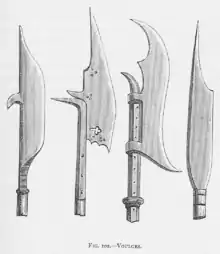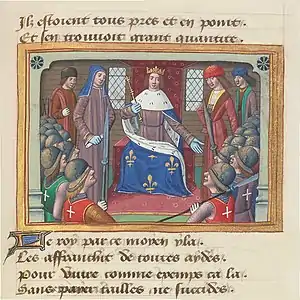Voulge
A voulge (also spelled vouge,[1] sometimes called a couteau de breche) is a type of polearm that existed in medieval Europe, primarily in 15th century France.[2]

Description
A voulge would usually have a narrow single-edged blade mounted with a socket on a shaft. The weapon could additionally feature shaft reinforcements called langets and rondel protection for the hands at the base of the blade.[3] Troops that used the weapon are called voulgiers.[4]
It is a weapon noted to have been used by the Franc-Archers[3] and is also depicted in artwork of their creation. There is a popular erroneous definition of the word voulge in modern times, which refers to a pointy cleaver-like weapon blade attached to the shaft with two hoops like a bardiche. This definition is incorrect and started in the 19th century with Viollet le Duc, and the weapon in question is an early form of halberd.[5]
 Voulges depicted in the hands of Franc-Archers
Voulges depicted in the hands of Franc-Archers
See also
References
- "Definition of VOUGE".
- Waldman, John (2005). Hafted Weapons in Medieval and Renaissance Europe The Evolution of European Staff Weapons between 1200 and 1650. Leiden. pp. 183–188. ISBN 978-90-474-0757-7. OCLC 704633881.
{{cite book}}: CS1 maint: location missing publisher (link) - "Historical European Polearms and other Weapons: The historical Voulge - what is this polearm?". Historical European Polearms and other Weapons. 2022-12-28. Retrieved 2022-12-30.
- Sargeaunt, Bertram Edward (1908). Weapons: A Brief Discourse on Hand-weapons Other Than Fire-arms. London: Hugh Rees, Ltd. p. 23-24.
- Waldman, John (2005). Hafted Weapons in Medieval and Renaissance Europe The Evolution of European Staff Weapons between 1200 and 1650. Leiden. pp. 16–17. ISBN 978-90-474-0757-7. OCLC 704633881.
{{cite book}}: CS1 maint: location missing publisher (link)